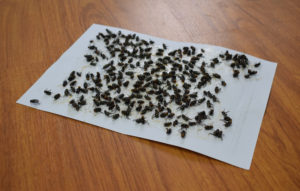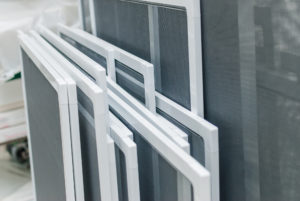How to Get Rid of Pests

August 1, 2017
4 min read
 Insects and other pests aren’t just annoying, they also pose a serious threat to people and property. So, how do you get rid of any pests that plague you now and avoid future infestations?
Insects and other pests aren’t just annoying, they also pose a serious threat to people and property. So, how do you get rid of any pests that plague you now and avoid future infestations?
Here are some tips for getting rid of — and preventing — pests.
Spot the bug
First things first: Identify the pests you’re dealing with. The most common summer pests are mosquitoes, ants, houseflies, ticks, termites, stingers (bees and wasps) and cockroaches.
Next, set sticky traps: They might not eliminate all the insects, but you’ll be able to identify where the infestations are and the types of bugs running around. Once you’ve spotted them, choose a treatment targeted to that particular infestation.
Pick your poison
You might have to spray, apply a liquid or powder insecticide, or even set traps on a regular basis. Be careful of placement, and avoid areas frequented by humans or pets.
Ants
If you have to destroy an anthill, there are a number of ways to do it, including drowning it, poisoning it or simply flattening it. But since you see a hill only after the queen has had her babies (who rapidly expand the old homestead), be prepared to dig deep — way deep — to make sure you get them all.
 Termites
Termites
DIY termite solutions don’t always kill the entire colony, and if you don’t know the extent of the infestation, your chances of success are even lower. Before risking further structural damage, hire a professional extermination company that will have the latest, most effective termite removal methods.
Stingers
Use a foaming spray to kill a wasp, hornet or yellow jacket nest before removing it. Choose one that sprays from the appropriate distance, and follow the instructions on the can.
Spray in the early morning or in the evening, when the colder temperature makes the stingers more sluggish. Wear protective clothing — gloves, boots and goggles — and duct tape your pants and sleeve cuffs shut so you don’t get stung.
When the nest is dead, clean up everything that falls to the ground so the poison doesn’t spread.
Prevention goes a long way
Bugs are everywhere, but there are a few simple ways to stop them from getting in and taking over. For all-season pest control, establish a quarterly pest prevention program that includes some or all of the tips below.
- As pretty as your landscaping is, it might be contributing to an infestation. Bugs love flowering shrubs, ivy, ground-covering greenery and fruit trees. Replace pest-friendly plants with ones that don’t attract them, and place them far enough away from your buildings so bugs can’t use them as a launchpad to the interior.
- Keep the property clean, and provide plenty of ways for residents to dispose waste. Many pests, like roaches, are attracted to paper — especially if it’s wet — so reduce piles of cardboard and paper products, and keep them out of damp places. It may be useful to give your tenants a handout with helpful pest-avoiding tips as part of their welcome package.
- Pests love moisture, so remove any standing puddles or stagnant water. Make sure water from downspouts flows away from the property. Also, ask residents to immediately inform you about leaky fixtures so you can repair them and avoid standing water.
 Install weatherstripping and screens to block pests from making their way inside. While you’re at it, double-check that doors and windows are properly sealed and fit tightly when closed.
Install weatherstripping and screens to block pests from making their way inside. While you’re at it, double-check that doors and windows are properly sealed and fit tightly when closed.- Find all the cracks, seams, crevices, gaps and holes that insects might hide in or crawl through, and seal them with mildew-resistant caulking. You can also install copper or stainless steel mesh with the caulking, wooden trim or screens to block the bigger gaps.
- Install sodium-vapor or halogen lights, which are less attractive to night-flying insects and appropriate for indoor and outdoor use. Also, use low-heat-emitting bulbs wherever possible, since bugs are attracted to heat.
- Pet waste is another way for bugs to infest your property. Lower the risk by installing pet waste stations with poop bags and garbage cans so renters can immediately scoop up and dispose of their pet’s lawn bombs.
If you have a renter whose apartment smells like a garbage scow, they’re practically rolling out the pest welcome mat — and jeopardizing your property value and the unit’s rentability. Include a clause in your lease agreement that allows you to mandate residents to clean up their mess. If the lease allows, deduct the cleaning fee from their deposits when they move out.
The best ounce of prevention is to encourage renters to report an infestation — whether it’s in their apartment or around the building — so you can eradicate it immediately. Educate renters on sanitation best practices and what to do if they spot a pest. Include clear and specific cleaning clauses in your lease agreement so renters understand their responsibilities for keeping the unit safe and clean.
Who’s responsible for pest control?
An implied warranty of habitability implies, by law, that the premises are fit and habitable for human occupation and will remain so for the duration of the lease. But common sense and doing the right thing won’t steer you wrong. Rather than haggling over who allowed creepy-crawlies to take over your property, take immediate action to eradicate them. You’ll generate more resident goodwill — and perhaps even some favorable reviews.
Connect with us!
Learn how Zillow Rentals can help you reach your goals.
Stay informed. Stay ahead.
Access exclusive industry insights, market trends, and expert tips. Subscribe now to receive quarterly Zillow Rentals newsletters!